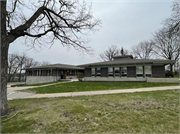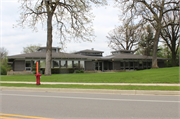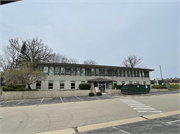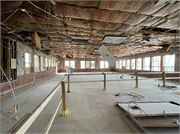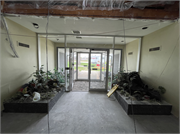| Additional Information: | "Situated on a wooded site, this small headquarters for a rapidly growing electronics firm, uses brick, glass and wood shakes to provide a homey yet functional atmosphere. The prime goal of the design was to locate the building on the existing site, retaining as many trees as possible. Interior offices open off skylighted core areas." A Celebration of Architecture: Wisconsin Society of Architects Tour of Significant Architecture, 1979.
2019 City of Fitchburg survey recommendation:
Consisting of an H-shaped plan, this concrete and brick-clad building is built into the site’s natural topography. From the west, the building appears to be only a single story. The recessed main entrance includes a set of glass double doors, above which is a hipped roof with clerestory windows. The blocks to either side of the entrance are topped with a hipped roof with wide overhanging eaves and, like the central entrance, the roof of each block carries an additional raised hipped section beneath which are clerestory windows. The eastern wing of the building is two stories, as the lower level is exposed, featuring battered concrete walls. Windows throughout the building are steel-framed with a lower awning opening. Two early newspaper photos of the building (from 1967 and 1971) confirm that the exterior of the structure has changed little, if at all, since its 1965 construction.
The subject 17,000-square-foot office, research laboratory and manufacturing building was erected in 1965 by Fabri-Tek, Inc. and opened in early 1966 as the Instruments Division of the firm. The company was established by M.F. Mickelson while he was an employee of Remington Rand Univac of St. Paul. Mickelson’s belief was that “a small company could produce computer memory components more efficiently than a larger computer manufacturer.” After two years of working part-time to prove his point, he resigned from his job in 1957 and established a Fabri-Tek plant on Minnehaha Avenue in Minneapolis. Soon thereafter, two plants were built in Wisconsin; one in Eau Claire and another in Amery, while headquarters remained in Minnesota. The new Instruments Division designed and manufactured “special-purpose equipment for use in the biomedical, nuclear and associated fields.” At the time of the Fitchburg facility’s opening, the company employed more than 2,500 people in seven facilities in Minnesota, Wisconsin and Pennsylvania. Scientist Robert W. Schumann served as the head of the Madison division, which employed over thirty persons by mid-1966. By that time, Fabri-Tek plants expanded to include locations in Hong Kong, Scotland and Chippewa Falls, Wisconsin. In 1967, the division was established as Fabri-Tek Instruments, Inc. and, four years later, was renamed Nicolet Instrument Corp. In 1992 Thermo Instrument Systems Inc. (a division of Thermo Electron Corp.) purchased the company and, today, it is known as Thermo Fisher Scientific.
2022 Section 106 Review:
The site along US Highway 18 was originally developed as farmland in the Town of Fitchburg on the southern edge of Madison, Wisconsin, but subdivided in the mid-twentieth century for development. There is no evidence of any buildings or other resources on the site previous to the 1960s. In 1965, Fabri-Tek, Inc. constructed a 17,000 square foot office building with a research laboratory space and manufacturing intended for the instruments division of the firm.
Fabri-Tek was established by M.F. Mickelson in Minneapolis, Minnesota in 1957 to produce computer memory components as part of the fledgling digital technology industry during the 1950s and 1960s. An engineer with the Remington Rand Univac, Mickelson believed that a small business would be more successful in developing such technologies than a larger one. Initially successful, Fabri-Tek expanded with two manufacturing facilities in Wisconsin, one in Eau Claire and the other in Amery while the headquarters remained in Minnesota. In 1965, the company expanded with an instruments division intended to produce customized components for biomedical and nuclear applications. The new office building in Fitchburg was completed to serve this branch. The office was called the ‘Madison’ division and initially had only thirty employees, though their numbers grew and was led by scientist Robert W. Schumann. Fabri-Tek employed over, 2,500 people by the late 1960s and had also expanded to Hong Kong, Scotland, and Chippewa Falls in Wisconsin. The office branch was renamed Nicolet Instrument Corporation in 1971 and was purchased by Thermo Instrument Systems in 1992. It has since served as an office in a larger Thermo Fisher Scientific campus until it was recently sold.
Designed by Madison architectural office of Law, Law, Potter, and Nystrom in 1964, the office building displays the Contemporary style. Specifically, a variation on Modern architecture with clear influence from Wrightian design such as the horizontal emphasis, battered concrete walls, pilasters between banded windows, recessed entries, clerestory windows, and a hipped roof line with wide overhanging eaves. The concrete and brick building has an H-shaped plan and is built into the side of the hill, with the eastern wing exposed with two stories and the western wing having only one-story. The exterior of the building maintains a high level of integrity and little of its materials and appearance has changed according to photos taken in 1967 and 1971 shortly after its original construction. The interior originally featured drywall partition walls, glass doors, wood paneling, a fireplace, carpeting, built-in furniture, and a reception area. These have all been subsequently removed.
The surrounding landscape has changed significantly since the building was constructed. Neither the adjacent parking lot or drives on the site match the original plans and historical aerial photography. Much of this is likely due to the fact the office was originally sited along the highway, which has since been expanded considerably with a frontage road following development since the 1960s that has filled in much of the surroundings with offices, warehouses, and apartment buildings that did not exist at the time of construction.
|
|---|

